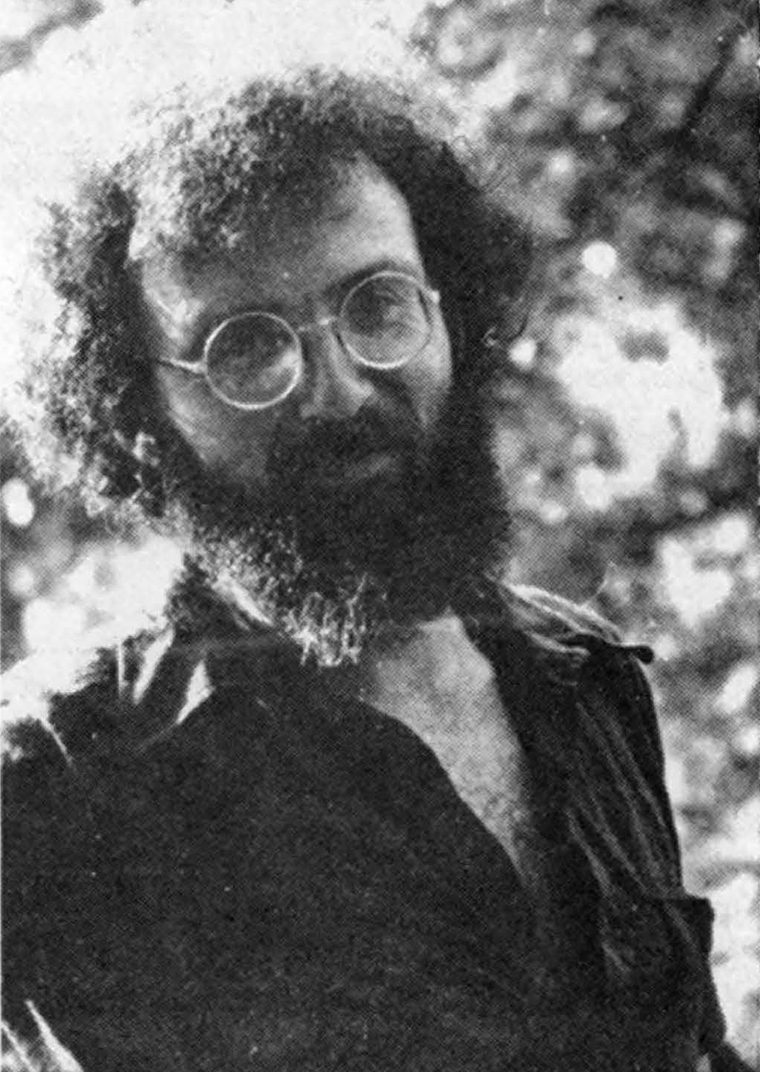
SY SAFRANSKY
To mark THE SUN’s tenth anniversary, we sent postcards to everyone we could remember who had ever been involved with the magazine — at least everyone for whom we had an address — asking, “What are you doing now, and what does THE SUN mean, or what has it meant, to you?”
This being a last-minute inspiration, the request bore an unceremoniously early deadline; honestly, I didn’t expect much of a response. I was wrong — so wrong that these letters have crowded nearly everything else out of this issue.
If they were merely congratulatory, printing them all — which we have — would be unpardonable. But there’s something else here, spoken and unspoken, a sense of family, and place, aspects of a magazine’s life that usually remain invisible. Notwithstanding all the praise for THE SUN and for me personally — my ego is smiling at me glassy-eyed; I’m putting it on a stern regimen of push-ups and anonymous good deeds after this issue — I think the love that shines through here tells us, first of all, how loving are the people who have been associated with the magazine. My thanks to every one of them.
It’s true I’ve often labored here alone, but the magazine has never been a one-man show. Ironically, for all the ways my personality flavors THE SUN — like some pungent, hopefully pleasant, aroma filling the house — the house itself was (and keeps being) built by many people, some of whom I’ve met and grown to care for deeply, some of whom have only been names. Indeed, the pictures that accompanied some of the Family Album submissions (we printed all the pictures we received) were revelatory, allowing me to match faces with my impressions built over the years from reading someone’s poetry or letters. I like the faces.
I hesitate to single out special people for thanks — so I won’t. Some people whose contribution to the magazine was profound aren’t included here. They know how much they’ve meant to THE SUN, and to me.
— Sy

CHRISTOPHER BURSK
© Roger Pfingston
Christopher Bursk
Langhorne Manor, Pennsylvania
I first heard of THE SUN through the marvelous poet Gloria Del Vecchio. It was THE SUN, specifically Richard Williams, then poetry editor, and Sy Safransky, who believed in my work enough to publish me at a time when no one else would. I was really struggling in my writing and getting rejection slip after rejection slip. Every night, I’d hitchhike home and my four-year-old son would say, “Guess what, Daddy, bad news again.” Then one night, he greeted me with a big smile and “good news.” And it was good news. He is now ten, I have had two books published, and it was indeed good news that someone was out there who said yes to my poetry. It was good news that THE SUN existed and still exists, and I will be always grateful. It is important that a magazine like THE SUN continue, a magazine willing to take risks, to publish odd and beautiful material, articles I often disagree strongly with, but applaud, poems by writers I respect deeply such as Gloria Del Vecchio and Pamela Perkins Atkinson, the work of the known and the unknown. THE SUN was and is still truly a source of light in my life.
Christopher Bursk’s most recent poems, from his book Place of Residence, were in Issue 94.
Sparrow
New York, New York
I live in New York City, in the neighborhood where I grew up. I work in a group home for retarded kids — we ride around in a silver-grey van listening to disco music, and we go to parks. I tell the kids stories, and sometimes I write the stories down later. The kids don’t understand what I’m saying. THE SUN has printed some of my stories. Maybe THE SUN understands.
Every once in a while I go to a demonstration. Usually the demonstration is about some place the United States has just invaded, or is about to invade. I call on all of you: oppose cruel wars!
To be human is to be Part Of The Conversation. THE SUN is one Part Of The Conversation I care about a lot. I’m thinking this Part Of The Conversation may save the Rest Of The Conversation.
Sparrow’s “Rain Poems” were in Issue 95.
Rob Brezsny
Santa Cruz, California
THE SUN played a rather critical role in my initiation as a writer. It was the first place I was published and the first place my work appeared consistently. The stuff I was creating in those days was rather confounding and uncategorizable. I doubt if it would have found a place in any other publication than THE SUN. You showed an amazing faith in the most soulful part of me, the part I valued most, though at the time it was often outlandish in its mathematically precise occult poetics. More than anyone else during that period, you gave me the confidence to cultivate my purest voice without compromise, and I thank you deeply.
At a later stage in my growth as a writer, you published a long piece of mine (“Californications”) that was a cathartic and quantum leap into a new, more personal and integrated style. That piece has stood for me as a prototype of a kind of writing that synthesizes all my various contacts with life. Again, I’m grateful.
These days I’m still postponing adulthood even as I get pushier about seizing the means of production. I’m finishing up my first book of born-again pagan Marxist poetry and lascivious feminist prose. It’s called Images Are Dangerous. It’ll be published by Jazz Press this winter, and I expect to be using it to get picked up by feminist women by this spring.
My band, Tao Chemical, has put out an album on our own independent label. We’re currently working on another recording project and trying to do the seductive things necessary to interest a major recording company into signing us to a contract. My mom says her cousin knows someone on the staff of Debbie Boone’s recording company, but nothing’s come of that yet.
Meanwhile I make money by writing an astrology column called “Real Astrology” for a couple of weekly newspapers in California. As soon as I get an agent or a couple of weeks’ vacation I’m going to syndicate it nationally.
Personal life? Sure why not. A good woman friend makes dolls and fetishes out of bones and fur and cloth. We pretend we’re mom and dad and play house a couple of times a week. I had time to see a movie a couple of months ago, but I didn’t find it as entertaining as the war stories on the TV news shows.
Congratulations Sy, on being such a good daddy to THE SUN all these years.
Rob Brezsny wrote under various names — Medea, Lamellicorn the Clone, and his own — in the mid-seventies.
Dee Dee Small-Hooker
Cary, N.C.
Somehow, it isn’t hard to believe THE SUN is ten years old. It always seemed destined to be around, if only to serve as some sort of public yardstick by which I could measure my life and my changes. I guess that is what THE SUN is to me: a mingling of all the voices I trust, all the voices that provoke me to examine my own habitual processes, my own hidden reservoirs of the good and the not-so-lofty. THE SUN demands. I cannot put whatever it is that bothered me (in any issue) out of my head or heart. THE SUN is my mother forever saying clean up your room. It gives me so many directions in which to strike out, to move. It opens up the dead end street (or at least suggests I get out of my current vehicle and walk about a bit).
But mainly, the reason I love THE SUN is because every month, without fail, someone confronts an issue that has me stymied, has me feeling so totally alone that I haven’t even the remotest idea of how to broach the subject with anyone. And then THE SUN shows up curled in my mailbox and the thing is shared, unearthed, and God, I am not alone and that is like a cup of salvation every month.
What I’m doing now: dancing, concentrating on ballet in that strange, nonsensical way of those of us do who are too old for professional careers, pursuing it with every fiber. Ballet is in my head and heart and muscles most of the time. Writing dance reviews regularly for The Spectator, keeping my hand in, my ear attuned to the rhythms that can live on the page. Suzanne is five and in school and wonderful and difficult in new ways. I’m trying a new approach: giving up being “spiritual” for being human, embracing some of the passions that are my (our) birthrights. After all, was I born in America in the 20th century merely to renounce all this? Still, this new practice is difficult in an entirely different way than renunciation was. I feel like I’m at the end of a long girlhood.
I’m amazed at how confused I can become — when I think I’m acting the authoritative adult I’m actually at my most childish, and perhaps vice versa.
Dee Dee Small-Hooker wrote “Facing Fear” in Issue 34.
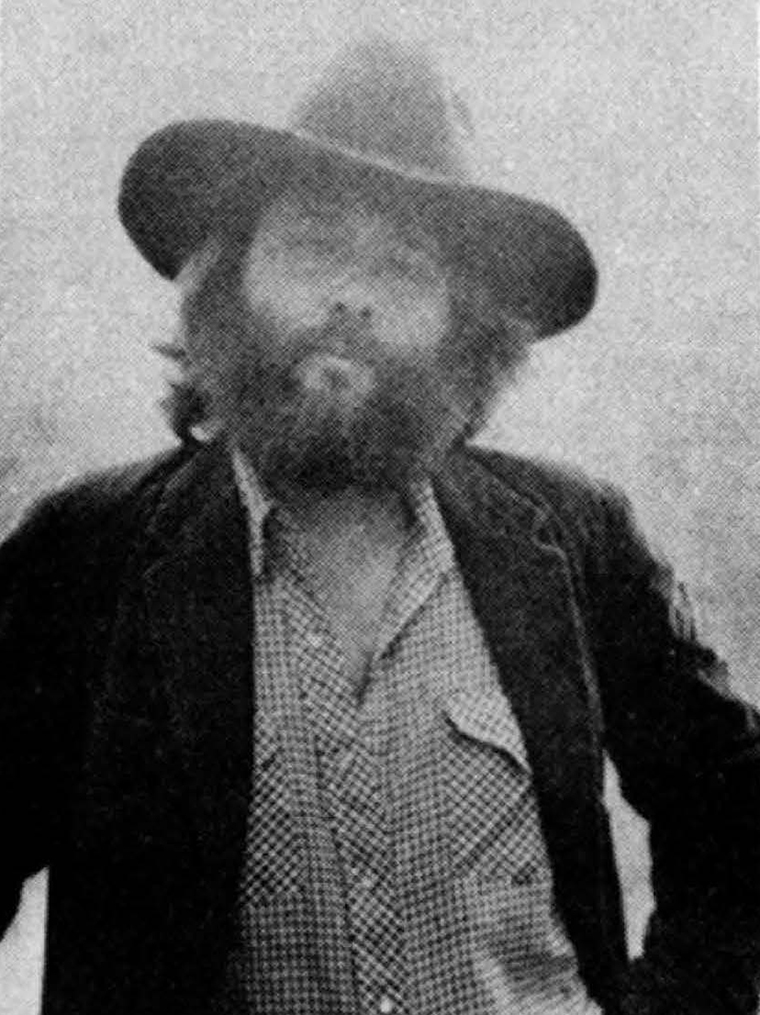
CHUCK TAYLOR
Chuck Taylor
Austin, Texas
What am I doing now? Right now it’s a Saturday night and I’m working in the bookstore. There are a bunch of obnoxious drunks outside — street guys giving poverty a bad name, or should I say a worse name for those who through no circumstance of their own are trapped in poverty. I find it hard to “love” my brother when the brother is a street drunk and leaves bottles in our parking lot and dumps out our trash and the wind blows it everywhere. Does THE SUN have any good advice, based on experience?
My life right now is full of work, and since I am the son of my father, who is a child of the Depression, that’s great. I am not only managing this bookstore but teaching English full-time at the University of Texas. I like my classes and I like my students. I’m tougher now — things don’t get to me like they used to. Indifferent students don’t phase me. Invasions and deaths of soldiers cause me to think hot but don’t shake the core as they did in the Sixties turning me then green and sick. Callousness? I hope not. I hope it’s a cagey wait till 1984 — then strike.
I’m making books now, too. Spending a lot of time doing paste-up and lay-out, consulting with printers, etc., for Slough Press. I’ve had such bad luck in the past three years with small presses which accepted my manuscripts and then, sometimes with good reason, failed to publish, that I’m saving myself the hassle and worry and doing it on my own. Now I have control over my medium — from the first written word to the selling of the finished book — and I like that responsibility. My next titles are: The Lights of the City (short stories) and Only a Poet (essays).
We live at the area at the back of the store with no bathtub, no stove, and no hot water. We have no TV or car. I’m 40 now, and I didn’t think I’d ever be much happier. My old lady Pat is the best old lady you could have, and my five children are just great. I don’t expect, being by nature a very un-New Age pessimist, for this happiness to continue. Life is just too unpredictable. But I’m having a whale of a time now — realizing my dreams, fulfilling all the weird kinks of my selfhood, society and its expectations — for so many years so overwhelming — finally out of my hair.
Chuck Taylor writes frequently for the US section. His essay “Making the Muse Real: Poetry and Spirituality” was in Issue 84.
Judith Gadd
Hillsborough, N.C.
I am now living on a small farm in Hillsborough, N.C. with my husband Tom and my daughter Jenny. I work at Wellspring Grocery in Durham — still messing around with books and herbs.
THE SUN has helped me to maintain my connections to Chapel Hill. Even during the four years I was in California, the ideas and thoughts shared in THE SUN had an immediate appropriateness to my own life that at times was almost uncanny.
THE SUN was started about the same time my daughter was born. I have watched both, fascinated through the many stages of growth. I am constantly in awe of the far-reaching effects of our thoughts and actions. Congratulations, Sy, and all the other fine people who have contributed through the years.
Judith Gadd collated more SUN’s than anyone can count back in 1974 when no one was counting.
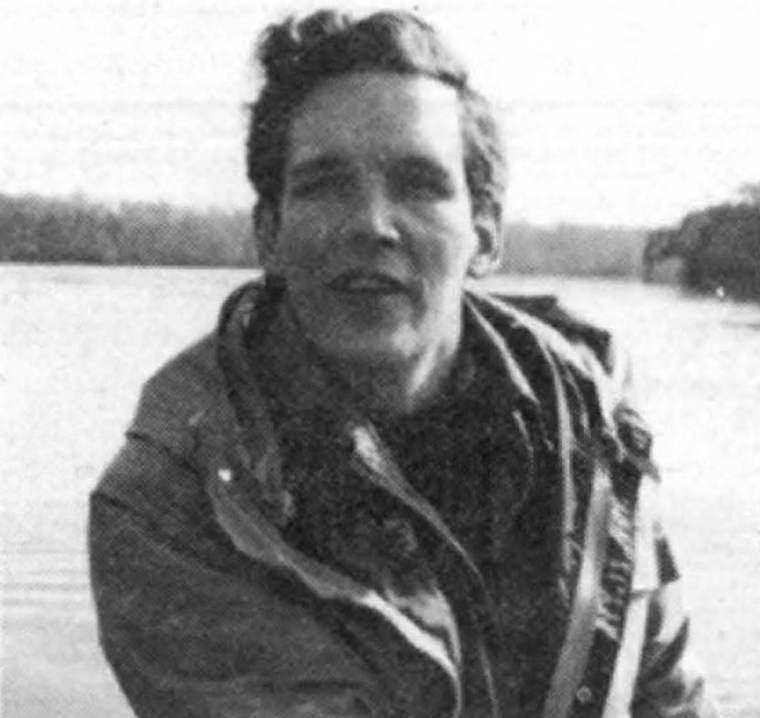
ADAM FISHER
Adam Fisher
New York, New York
Me: still painting apartments in NYC, nuthin special.
As to THE SUN. A conundrum in my mind, though less so as time passes. To me THE SUN offers a place where people can express themselves about a broad aspect of life, though surely not the only aspect. Perhaps it is like the east wind blowing sometimes hard, sometimes soft, sometimes just whispering, sometimes laying the grasses flat. Do I say “spiritual” to describe the aspect? Or maybe “new age,” though that sounds old. Perhaps THE SUN is just a place to grope and stretch, scratch and bleed, tell fairy stories or outright lies about some soft freshness that is nowhere foreign, never named. Some say, “Impossible!” but I say, “Don’t be ridiculous!” A good story or a first-class lie is hard to find and sorely missed. I for one hope THE SUN will shine another ten times ten.
Adam Fisher wrote “Random Notes on Spiritual Life” in Issue 90.
Gerard Saucier
Berkeley, California
THE SUN and I lived in Chapel Hill together for five years. But I got to know it only at the end.
You see, I thought THE SUN was New Age. So I was simultaneously respectful and intimidated. I pictured Sy Safransky as a cocksure blonde into spiritual practices and organics. That image was too strong. I felt like its shadow.
Imagine my surprise when I did get acquainted. THE SUN was full of shadows. Each member of the staff was going through their little hell. I was going through my own, for sure, during these months in 1981 when I worked there. But no one at THE SUN ever told me to transcend my pain.
And that is the secret of THE SUN. It is not all light. It moves with the dark, not afraid of it, not against it. And so it finds its light.
This secret in which THE SUN shares has become crucial to me. It hovers round my inner work, helps my angels and demons stay on speaking terms. And the secret informs the psychotherapy I do. Jung calls it integrating the shadow. He too was a walker in the dark.
Gerard Saucier handled subscriptions and typesetting ever-so-deftly in 1981, and has written for the US section.
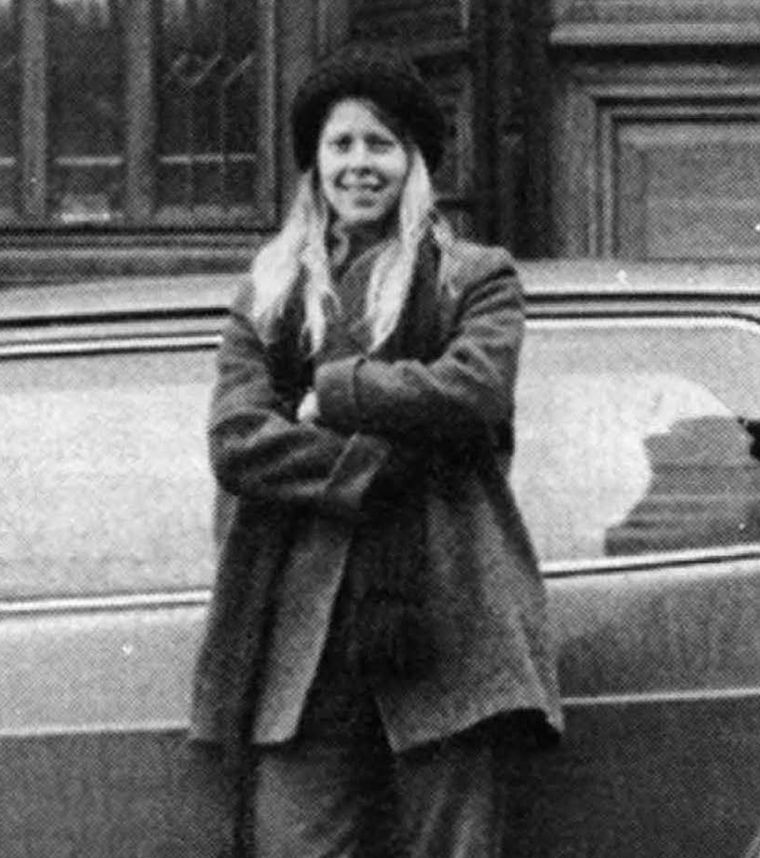
SUSAN WALLIN
Susan Wallin
Minneapolis, Minnesota
Today is one of those lovely late Fall days where the wind is blowing softly and I’m watching the remaining leaves detach themselves. Here in Minneapolis there is a feeling of gathering inward — of hoarding before Winter closes in, sometimes with very little warning.
I can imagine there are still some very warm days in Chapel Hill. Perhaps Sy is sitting on the stoop reading manuscripts and letters and John Cotterman will appear in the doorway for a break from his typesetting to chat or straighten up the front yard a bit.
I appeared at THE SUN’s doorstep after a long stint as production editor at Car and Driver magazine. THE SUN became for me, among other things, a place to meet people, an opportunity to work with kindred souls, and a place to learn more about publishing. It was also a welcome respite from the 9-5 work day.
Up here in the north country I continue in publishing as a publication assistant in the advertising department for Training magazine (a human resources development publication) where I hope to use skills I acquired as circulation manager for THE SUN. I continue to read THE SUN which, like my work there, prods me into the places where I must confront and meet myself.
More than anything else, for me, it was the sharing of thoughts, feelings, fears, sorrows, and dreams that I remember. Through this I came to new understandings about others and myself and the journey we help each other with.
Susan Wallin was circulation manager of THE SUN in 1982 and 1983.
Paul Rest
Santa Rosa, California
THE SUN means an almost undefinable softness which comes with each monthly issue. It is similar to the most affectionate hug I receive from my daughter — not indulging, but very there, very present and live, full of love.
Thank you SUN. And HAPPY BIRTHDAY!
Paul Rest wrote about “Things I Make” in Issue 93.

JIM THORNTON
Jim Thornton
Iowa City, Iowa
1977: On a mahogany table in Sewickley, Pennsylvania, I set down my accumulated juvenilia. For five years, these dozens of little pocket notebooks had been my constant companions — at bars, at Episcopalian church, at the trysting sites, at the rejection spots. With my saintly mother barking ever so slightly in the background (dinner guests were scheduled to arrive in a few hours, and my notebooks seemed at times preoccupied with vulva and the like), I began the project I knew I was born for: The Portable James Thornton, A Cartoon Autobiography. In two hours, I was finished. The notebooks lay pillaged of jokes, and a 90-page stack of cartoons sat where once dahlia blossoms had floated in a Steuben glass bowl. Ah! The transmorgrifications of Art!
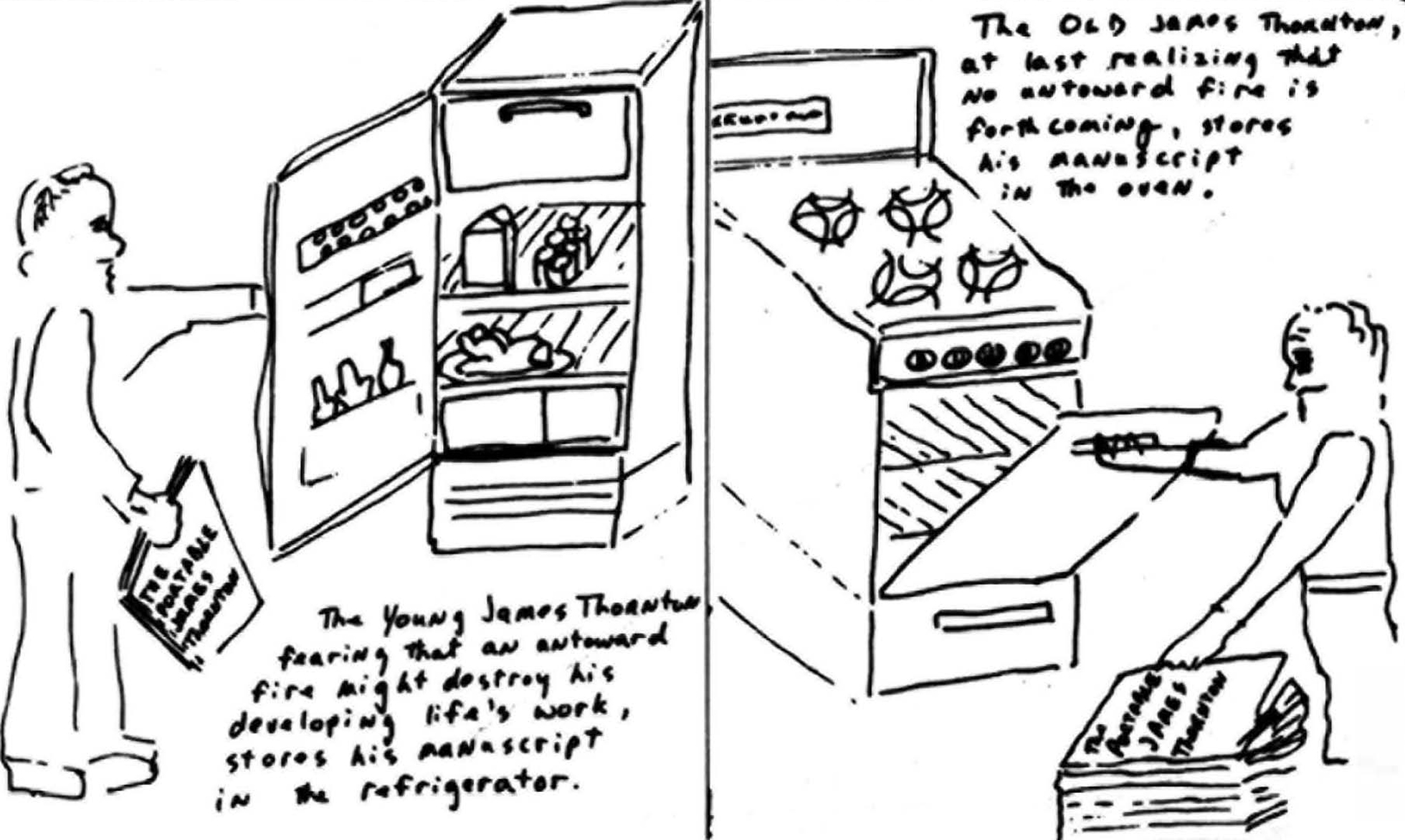
By now my mother could feel the breath of party guests about to burst upon us. Due to regrettable short-sightedness on my part, I had placed my cartoon, “Etiquette in the Nudist Leper Colony,” on the top of the stack. This clinched it.
In a flash, the once succouring eldress of a mother turned into a hard-ball matriarch. The Portable James Thornton ended up in the basement inside a dessicated aquarium where dehydrated angel fish mixed with the turquoise gravel, and the desultory footprints of my twin brother’s now extinct baby crocodile seemed to point an undeniable path for my literary future.
Several months later, my brother told me about THE SUN and suggested I send some cartoons. I retrieved Portable James from the basement — not an altogether easy task since several mud daubers had begun nesting therein and feasting on the freeze-dried guppies. Sy Safransky, heir apparent to Maxwell Perkin’s sobriquet, “Editor of Genius,” most graciously decided to publish me. He did, however, opt against the nudist leper colony cartoon — why, I have never quite figured out. Perhaps a massive letter-writing campaign from current readers can bring this neglected black humor masterpiece to the sophisticated audience it deserves.
1983: What a pompous, misguided schlemiel I was in my younger days! Well, that’s behind me now. My juvenilia period — with its preoccupation with the vulgar, the tasteless, and the shocking — began sometime in nursery school. That’s when I first entertained “mutilation thoughts” about my teacher, Mrs. Johnson, best described as a rat terrier in a skirt. The juvenilia period continued full-blown through my college days, my fifth grade teaching days, and my first year at the Iowa Writers Workshop. Here one of my teachers — Southern novelist Barry Hannah — trashed my writing with such a vengeance that it did something to my brain. Thus ended my juvenilia period in neurological rearrangement. I wrote a short novel, Dexter, and managed to win a Michener Fellowship for it. (Any interested book editors out there are invited to submit a publishing contract for Dexter.)
I then signed up for Iowa’s masters program in journalism and became a columnist and occasional feature writer for the Iowa City Press-Citizen. I fell in love with the wondrous Debra Jean Hines and molted.
THE SUN has meant and continues to mean a lot to me. My first publication was in THE SUN. This is like a first kiss — the thrill of it will linger forever in my soul, my limbic system, or wherever it is that joy is encoded.
Since studying journalism, I’ve found new reasons to appreciate THE SUN. To start a magazine from scratch — especially one without obvious appeal to vested commercial interests — seems to me an enormously difficult undertaking in America. I appreciate THE SUN because its very existence is proof that not everyone is a “Keynesian man” — that people like Sy do sometimes act out of other motives than financial self-interest.
Moreover, I believe THE SUN is an important alternative voice in an era dominated by mass media. The daily press may occasionally write about individuals as emblems for larger national issues (note the facile interviews with unemployed steel workers or the bereaved relatives of Grenada Marines). The Wall Street Journal has even made a formula out of this: five or six lead paragraphs focusing on emblematic individuals, then a “nut paragraph” which serves as a transition to the “larger issues” involved.
THE SUN’s approach towards individuals is profoundly different. In my favorite part of the magazine, the Readers Write section, a splendid array of individual human experiences every month reaffirms our diversity and our commonality in a way that has little to do with trends and institutions. My one word of advice to Sy is this: strengthen this section even more. Actively solicit as diverse a range of opinion as you can get. Ask your readers to help — get Russians to write, get mental patients, business executives, computer fanatics, bag ladies, the franchised, the disenfranchised, technocrats, radical yogurtists, saints, and spoiled brats. To read THE SUN now is an immensely humanizing experience. I suppose I’m just greedy for more of what it already does so well.
For what it’s worth, Sy, thanks for everything you have given to me already. Major congratulations on THE SUN’s tenth birthday — and best wishes for the decades to come.
Jim Thornton’s “Advice from the Lovelorn — Confessions of a Male Chauvinist Prig” appeared in Issue 53.
Bodhi
(Swami Anand Bodhisattva)
Rajneeshpuram, Oregon
What I’m doing now: work as worship and celebration in a city under siege. Rajneeshpuram, targeted by all the bigots of the Pacific Northwest as the place at which to vent the spleen generated by their own crummy lifestyles. But the neurosis and anger of our opponents in no way touches the joy I feel to be living and working with Bhagwan’s lovers in this magic Buddhafield. I’m doing farming, construction work and music. Two nights a week I play drums with the Rajneesh Country Band at Zorba the Buddha Rajneesh Restaurant and Nightclub in Portland. This is the redemption of a dream deferred when I decided, at 21, not to be a professional musician. Nineteen years later, the intervention of an enlightened master put me back in the saddle behind the tubs, and its a charge!
What THE SUN has meant to me: a burst of light, a unique public expression of one man’s commitment to understand himself and touch the unknown within, always moving, moving on, moving in, more human every day. A beautiful magazine, the outward flower of an inward movement, giving so many writers the chance to touch themselves and each other. THE SUN is more than rare; it’s one of a kind.
With lots of love, I want to invite SUN people to come visit us here in Oregon and compare what you see in person with what you may have seen in the media. Here, we’re living with a Christ, a Buddha, and the impossible just keeps happening!
Bodhi sold advertising for THE SUN in 1979.
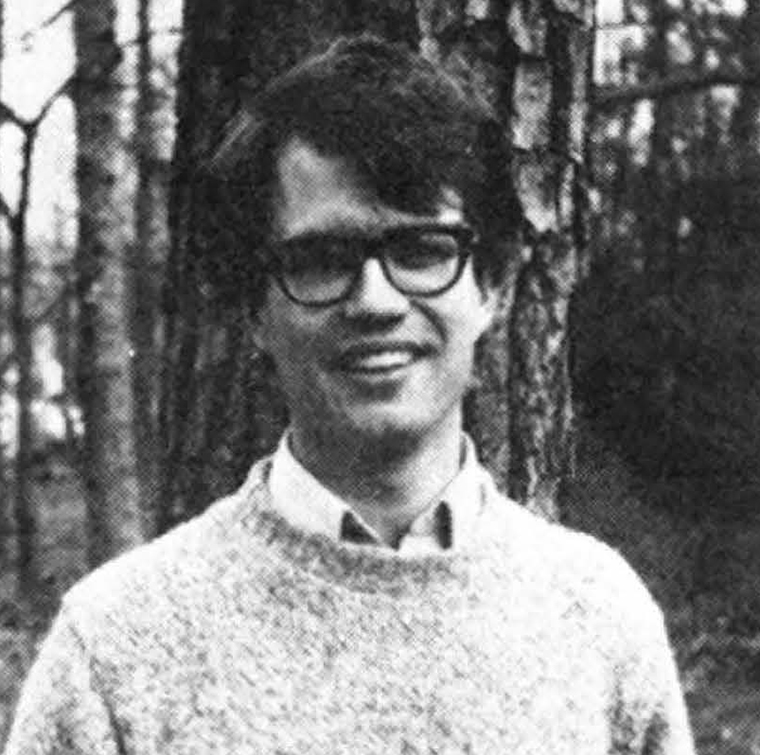
DAVID GUY
David Guy
Durham, N.C.
THE SUN was the first magazine ever to publish my writing, and as such holds an exclusive place in my affections. In my nearly three years of writing monthly book reviews for the magazine, I honed my skills as a reviewer, and always received very fine treatment from the editorial staff (which consisted for the most part of Sy Safransky). In working for Sy and in long evening talks which I had with him, I came to feel more and more secure in my identity as a writer. I still read and enjoy the magazine every month.
At present I am what is known as a full time writer. I have published two novels — Football Dreams and The Man Who Loved Dirty Books (just out this fall from NAL Books) — and have reviewed for the Washington Post, the Chicago Tribune, and USA Today. I still feel that I am engaged in the same task that occupied me when I wrote for THE SUN, and, for that matter, before I was published by anyone. It is work which I very much enjoy.
David Guy’s book reviews appeared from 1977 through 1980.
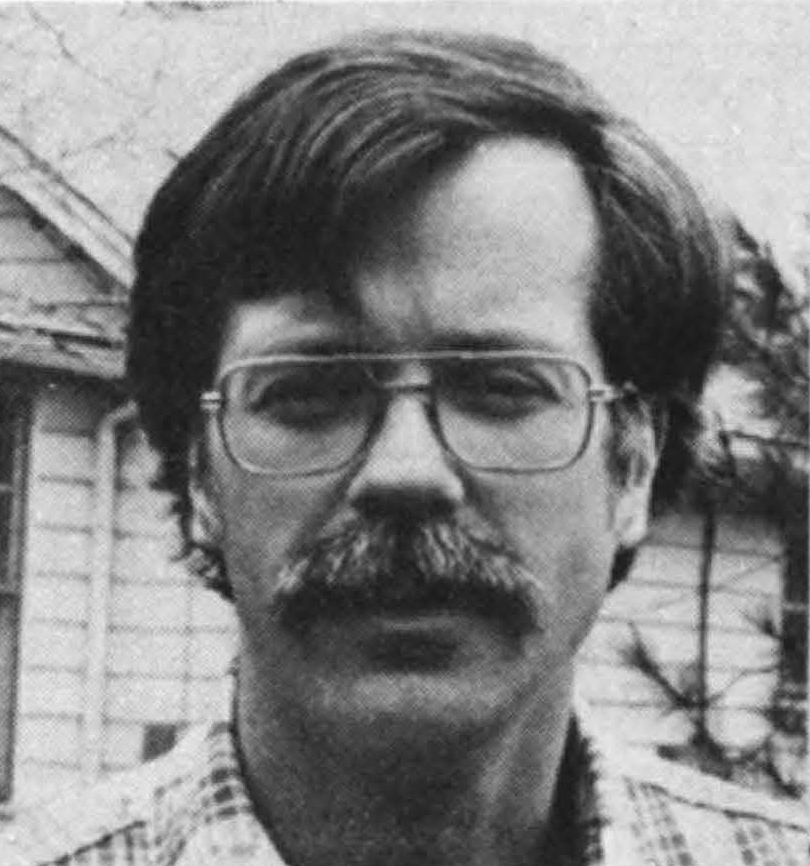
JIM RALSTON
Jim Ralston
McHenry, Maryland
I am presently living out of my car, and a heavy sleeping bag, to be near my kids in western Maryland. I work part time at Garrett Community College, but foresee moving to a city within a year or two.
Work in progress includes a book co-authored by Jorn Bramann, Gainful Unemployment, where we look at the positive possibilities of the unemployment crisis from both a personal and an analytic point of view. For my part, I take the idea of “unemployment” as far as I can stretch it, and suggest through a personal narrative that any situation which forces a person into self confrontation, self contact, is ultimately the ground for the most fruitful kind of work there is to do.
Also, I am writing a book on what I think it means to be religious, to be spiritual. This is particularly exciting to me, as it puts me on the edge.
Also just finished another children’s book (waiting for illustrations to be done) entitled: No Peas and Carrots Till You Finish Your Ice Cream.
Choice of Emptiness will come out in a second edition this fall or early winter.
My great hobby is acting; have been in two plays recently: Twelfth Night and Skin of our Teeth.
THE SUN continues to be the best magazine going. I smile to see it in my mail, and I feel proud to be a part of it. Last year I gave a gift subscription to a friend of mine who died this fall. Sy, it was a great help to her — for one thing it led her to Stephen Levine’s Who Dies?, which became a great companion. I read it thoroughly, sometimes underlining, and I feel I know you through its pages. It is only through extreme financial poverty that I haven’t resubscribed recently, but now I am able to do so and enclose my check.
P.S. Forgot to mention I won a National Endowment for the Humanities Fellowship to study at Yale last summer. The seminar was entitled, “Freedom and the Religious Personality.” The experience was remarkable in many ways, but a very wonderful thing happened to me right at the end. A fifteen, twenty year ambivalence fell off my back, as I realized that I was an outsider — and that was my rightful place to be, that was the true home of my soul, working on the outside. This realization has made a lot of difference for me — to move quietly to the outside, without rebellion, without anger — knowing that those who work on the inside are equally important in the scheme of things. My home now is my work, my relationships, nature — all fluid, and the secret of my inner self on which I rest, on which I float.
Jim Ralston’s book Choice of Emptiness was excerpted in Issue 86.
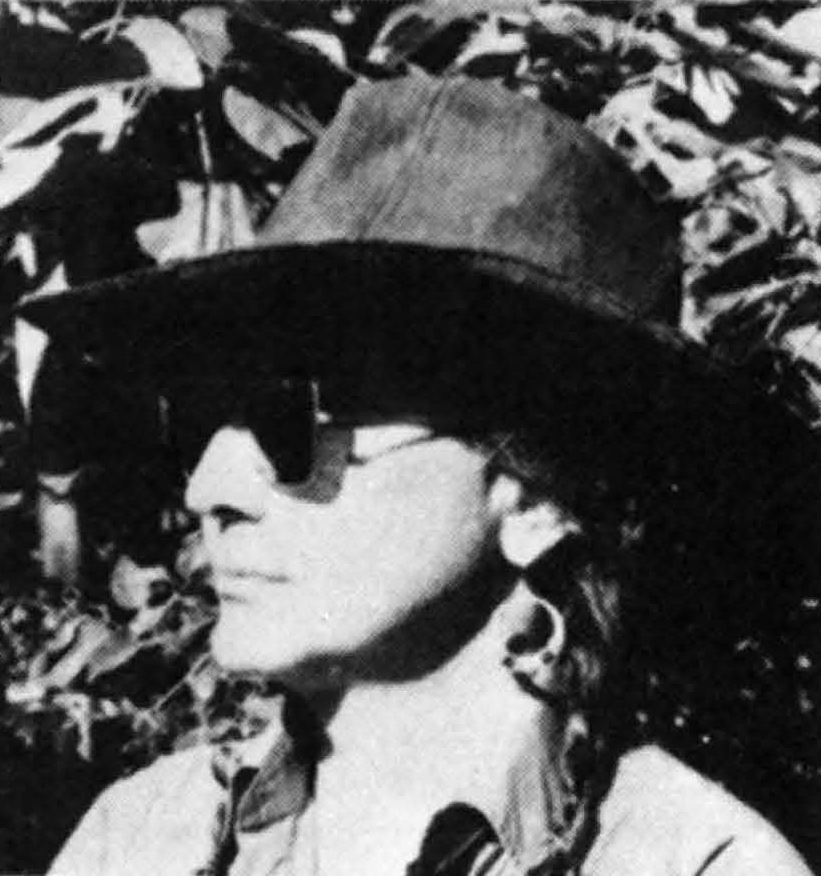
ROXY GORDON
Roxy Gordon
Dallas, Texas
I’ve been writing short stories for the past year now. Most of them are aimed toward a collection based around the country where I grew up in West Texas — and they largely deal with Indians and the Indian influence there. I just put together a Native American Reading at a bookstore here in Dallas and may be participating in some other similar readings. I do a good deal of book illustration these days; most of that is Indian oriented.
My wife and kids and I are building a house on a hilltop on my people’s land in West Texas. Right now it looks like a hunting camp. Sooner-or-later, I want it to look like a Cammanchero fort on “Gunsmoke.”
I have rather special interests and not the best attention span, so I don’t really read many magazines. But I do read every word in every SUN I get and though I may or may not agree with all those words, I like to see such voices coming together. And I like the attitude of a magazine that brings them together. I presume the content reflects the attitude of the editor and I wish him and his magazine a continued strong voice.
Roxy Gordon’s most recent story was “Pilgrims” in Issue 94.
Thaddeus Golas
Highlands, N.C.
In California I lived last at an altitude of 2500 feet. Now I am in western North Carolina at 4500 feet. I attribute this rise in elevation to my ultimate self-teaching: “No matter what happens, I am conscious all the time.”
On the day THE SUN arrives, I go through it to see what’s in it before opening any other mail. That is a true compliment.
Thaddeus Golas, the author of The Lazy Man’s Guide to Enlightenment, wrote “Understanding Pain” in Issue 82.
Elyse Towey
Moneta, Virginia
In 1972 , when my brother moved from New York to North Carolina, I reacted as if he had moved to the moon. What he had reported seeing and experiencing there was truly another world from the reality he had left (and in which I had remained).
He had given up a high-stress, well-paid journalistic career in the big city, and opted for the charm and warmth of a southern college town. Now that was an awesome decision to me! I admired his courage, and I missed his presence enormously.
When THE SUN first made its debut, as a tiny photo-copied pamphlet, it was a small but significant symbol of my brother’s success — Sy had started his own magazine! I had followed all the school papers he edited, and the newspaper stories he wrote, and cherished the few letters I received from him over the years — but here was a real publication! A minor miracle being sold for 50 cents on Franklin Street.
Like my brother, THE SUN has gone through many changes over this decade they’ve shared. Sy’s joys and sorrows, insights and confusion were woven throughout the evolution of THE SUN. Though many changes and challenges affected Sy’s life (and believe me, there were many) the one constant you could always count on was THE SUN coming out. It was a difficult partner, he would sometimes admit, but his devotion to it was unquestionable.
Like most difficult partners, THE SUN has demanded quite a bit from Sy — time, money, sacrifice and love. Happily, it has grown more mature and lovely with the passing years of attention. If the best measure of loving is having your beloved strong and complete on its own, then THE SUN is a reflection of that non-possessive caring.
In its beginning, THE SUN was not only edited, but often mostly written by Sy. Over the years, however, the thoughts of many others have been woven into its design. It has grown more sophisticated in its look and language, yet has maintained its integrity and purpose. THE SUN is a unique experience — sometimes I think it’s too special for the word magazine. It is reflection of the heart and soul of someone I personally love and admire, but it is more. It is, by now, the creation of many beautiful and wise and struggling people, some of whom have been very dear to me, some I know only through the feelings they have given me in print.
THE SUN is a magazine of ideas; I confess on occasion I can’t understand all of them, or find the time to read all of them, but sometimes, I fill a hot bath, a cold drink and read THE SUN until I am laughing, or crying, out loud. Those are the moments that I treasure THE SUN, for it is a sign that my ideas are shared by others; that there are answers I hadn’t found elsewhere; that there is a community of spirit and mind that really exists out there. And it’s a sign that Sy, like THE SUN, is still shining.
(There are just two things I’d like to mention briefly: THE SUN has the best ads I have ever seen anywhere — they are beautiful and I always understand them; and a subscription to THE SUN would make a wonderful present for your friends who like baths.)
Elyse Towey has written for the US section on “Brothers and Sisters,” “Good Marriages,” and “Eating.”
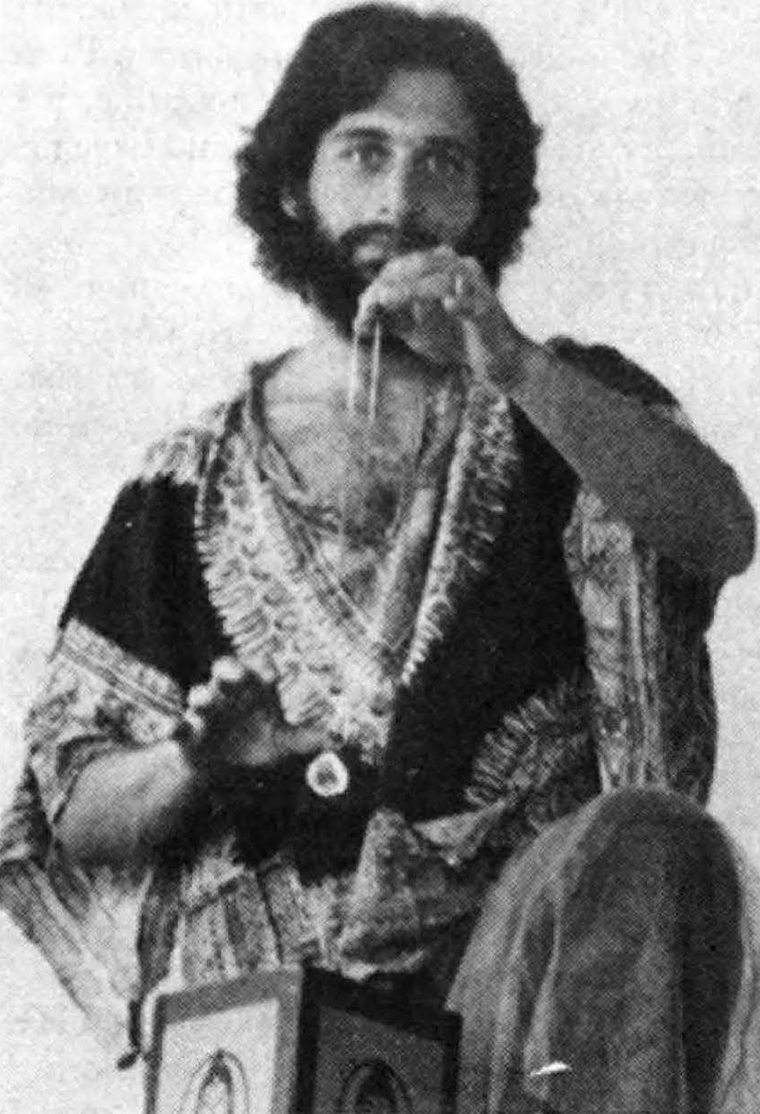
HOWARD JAY RUBIN
Howard Jay Rubin
Durham, N.C.
It’s 3 a.m. and once again I’ve waited until the last possible moment to write my monthly SUN feature. Why do I do it? I don’t know. And for that matter why did I ever answer a job-ad that read “No pay, but we expect commitment and hard work. . . .”? No logical reason. But from the first issue I saw, a copy found abandoned on a chair at a Ram Dass benefit, THE SUN has followed me around, sticking to my feet like old chewing gum. So one day I roamed, wide-eyed, into Sy’s office (probably looking a lot like the magician character pictured above), and said, “Hi! I want to learn about writing, and uh, networking. How can I help?” It took a while, but we figured it out: the best help I could be around the office was to stay out of the way. Then one day Sy suggested I do an interview for the magazine. I wrote a letter to Pete Seeger and. . . .
Well, that was about three years and twenty-two(!) SUN interviews ago. By now the beard is gone, so is the long hair. I’ve traded some old illusions for new, learned a few things, forgotten a few more. And I no longer wince when I say I’m a writer. I could rattle on about the remarkable richness I’ve felt in THE SUN, of the beloved friends I’ve met under the pretext of interviews, or the insidious gnome that keeps throwing jewels up through the office’s creaking floor boards and then stealing them back too quickly, but enough said.
To put it simply: there’s nothing in this whole mesmerizing world (present lovers excepted) that’s been more important to me than working with Sy and THE SUN.
Howard Jay Rubin has interviewed Swami Kriyananda, Peter Caddy, Reshad Feild, Wavy Gravy, Paul Winter, Tom Paxton, and Allen Ginsberg.

PETE JONES &
LIL ROYAL JONES
Pete Jones
Chatham County, N.C.
THE SUN has lasted ten years because it touches readers who search for life’s meaning. In Sy, they recognize a fellow celebrant-sufferer-seeker who expresses their inmost thoughts without shame, ever more penetratingly. And one who, as time passes, does so with more clarity, simplicity, humility and tolerance for our frailties.
Pete Jones has had fewer words in THE SUN and more influence on it than most.
Lil Royal-Jones
Chatham County N.C.
A tall, well-stacked woodpile in November gives me a feeling of wealth and security. Likewise, when I see the stack of SUNs on the coffee table, I feel rich and enriched by the myriad collections of thoughts and words expressed therein.
Both of these “stacks” are sources of warmth, light, and energy. I give thanks!
Lil Royal-Jones wrote on “Good Marriages” in Issue 89.
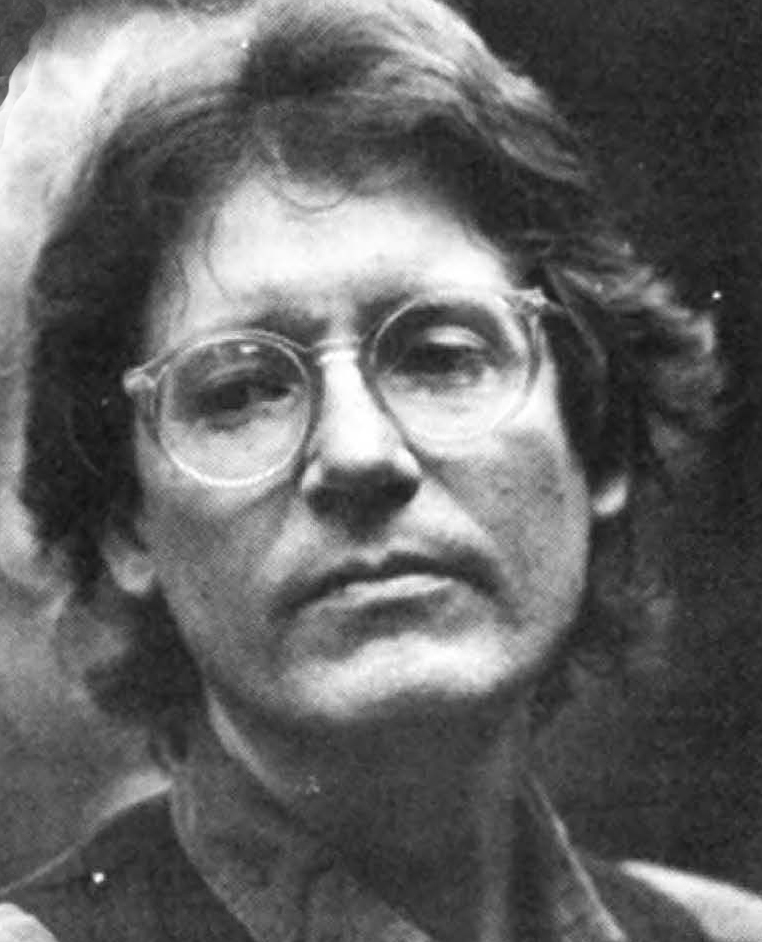
JOHN ROSENTHAL
John Rosenthal
Chapel Hill, N.C.
I am compelled by an inner law of my own making to admire THE SUN. It is a constant testimonial to the fact that cynicism is not the only choice. I mean, imagine what a monster of social consideration, what cool guys we’d be if we took our identities from the nonsense projected by most magazines. Even The New Yorker, my favorite magazine, if I read only the advertisements, would have me dressed in the most perfect moccasins and languishing only at the proper resorts. Who needs to be so swell all the time, to “know” all these right things? A few years ago a friend of mine in magazine publishing told me that great danes were “in” and small dogs were “out.”
But I am fickle in my admiration. Much of THE SUN bothers me. It seems to posit the existence of gurus, and I don’t much like these people. I don’t like the clever way they keep things vague, their reductions of our overwhelmingly rich Western culture (of which, it turns out, they know very little), and their sly way of converting their search for truth into a contemporary need for a little peace-of-mind. They play at being nice guys and bully you with spirituality.
And too often I find the pages of THE SUN a sort of jargon-ridden description of how things are. I never hear the word “stress” anymore without imagining someone who conceals behind a mask of smug certitude the fear of getting his hands dirty in this difficult business of living. One person interviewed in THE SUN was so afraid of being polluted that he wouldn’t jog anywhere except on his bed. He thought he was safe from everything in his room with the windows closed. I would rather let my son read Hustler magazine than the words of that fellow.
But if virtue itself is occasionally limp, The Sun’s search for it isn’t. I can always count on THE SUN for its honesty and lucid intention, its refusal to lower its perspective in order to accommodate a smarter but lower angle-of-vision. It would be so easy for the editorial direction of THE SUN to shift ever so slightly, to be less insistent on sharing the “light,” to find a reason to solicit a hipper notion of things. The modern solution is usually to make a potpourri of the good and the bad, hoping the bad (selling a repulsively hip identity through advertisements) will allow the good to labor on (an essay by Norman Mailer). THE SUN doesn’t do that, and it therefore always reminds me of a certain limited possibility which is, after all, a moral event. From time to time I need a reminder.
John Rosenthal’s essays include “Stealing Souls — Thoughts on Photography” in Issue 88 and “Insisting on Love” in Issue 63.
Gayle Garrison
Little Rock, Arkansas
Here I am at 31, a happy astrologer living in Little Rock. I’m also in school, and will at last complete my B.A. in Professional and Technical Writing from the University of Arkansas at Little Rock in May 1984. Yoga classes are still part of my life: I teach for the Continuing Education Department at the university.
I’m active with Unity Church of Little Rock, leading meditation and doing volunteer work there. Unity has helped me strengthen my awareness of Divine Supply in all forms, and I’m learning to live in thanks.
I remember the early issues of THE SUN because they stimulated my hopes and visions for community and spiritual growth. Later, THE SUN became for me a whirlwind of voices, some seeking direction and others offering it. More recently, THE SUN can still call up visions of the good life in North Carolina, an earth-touching breath of clean woods air.
Gayle Garrison’s essays appeared in 1975 and 1976. Her last article was “Thought: Shelter of the Future” in Issue 15.
Larry Taylor
Durham, N.C.
Recently I saw the movie, “The Big Chill.” The film points out a particular syndrome to which many of us came to age in the late sixties and early seventies can probably relate. Ten to fifteen years ago discarding the ideals of the institutions of my parents’ generation was definitely part of my agenda. Trying on new or radical causes seemed the antidote to a poisonous world not of my making. Many of the “New Age” spiritual activities fit that syndrome. The stranger or more exotic the path was, the more it appealed to me. But the heart seeks for home and the mind wants to understand the seeming meaninglessness of existence. What sincerity I could bring to the divine search only served to heighten the pain of disillusionment with greedy or power hungry “gurus.”
But sooner or later I felt I had to make some accommodation with a tainted system that could not be escaped or meaningfully changed. I can well remember telling a friend in 1973 how I was going to put my spiritual work on the “back burner” until my material life was in proper order. By this I guess I meant a salary with a sufficient number of zeros. It wouldn’t work, though. After five years of chasing after success I could feel myself slipping into a neurotic quagmire. I realized that if my spiritual life was not right then everything else would ultimately be destroyed by the darkness within.
Since 1974 THE SUN has kept the faith. Having seen many similar publications come and go, I applaud THE SUN’s staying power. It makes the world a less chilly place to be. In its pages I recognize kindred souls who may have thrown out the revolutionary banners and established themselves in the working world but who have discovered a continuing thirst for inner peace and meaning. May THE SUN shine for decades to come, secure in the knowledge that it speaks of things that have the hint of eternity in them.
Larry Taylor has written on “Brothers and Sisters” and on “Possessiveness and Jealousy” for the US section.
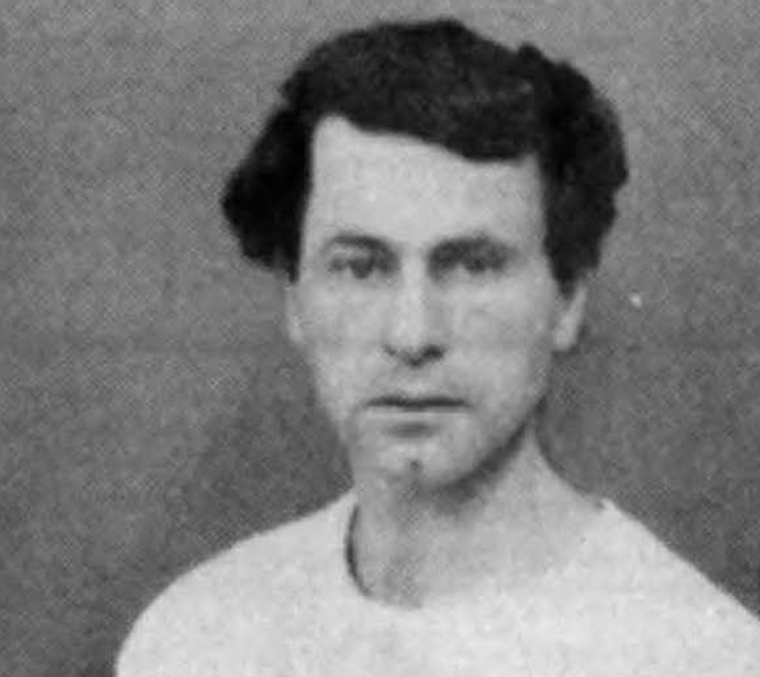
DAVID KOTEEN
David Koteen
Umpqua, Oregon
Congratulations, Sy! Perseverance furthers.
Here am I — I just returned from the annual Earth Community Network gathering. Ongoing colloquy of role and needs of intentional communities. In one of which I live: Hearthwind. Father of three boys, evolution carries me presently to the practice of Massage/Polarity, delights of contact improvisation dance, land-oriented chores, much typewriter time.
THE SUN remains an aesthetic core around which function and feelings are tightly wound. The field generated by its continual motion provides me with an indispensable source of energy.
Blessings on the next ten.
David Koteen wrote “Cholestiatoma” in Issue 87 and “The Lucy Syndrome” in Issue 93.
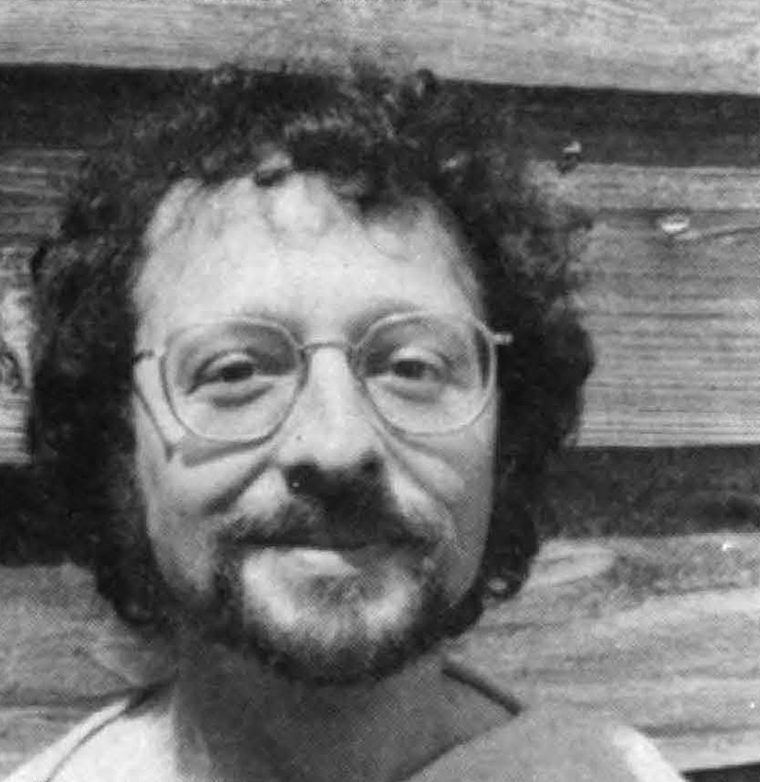
STEVEN FORREST
Steven Forrest
Chapel Hill, N.C.
When I first began making my living as an astrologer, the biggest problem I faced was figuring out how to let people know how my work was different from the usual “this-means-you’re-moody-and-will-die-young” kind of astrology. Word-of-mouth is slow and ads seemed tacky to me. THE SUN supplied the solution. I published a series of articles, and I know they were instrumental in helping to get my name around. The snowball has been rolling for many years now. This spring, Bantam will publish my first book, The Inner Sky. Tracing “first causes” is a task like computing the ultimate value of pi, but I suspect that without THE SUN my momentum would have been much slower in developing. Thank you, Sy, for ten years of help, of courage, of respect for human diversity, and of pure fascination.
Steven Forrest’s most recent essay was “Going to the Movies” in Issue 75.
Louise Harris
Durham, N.C.
I used to enjoy THE SUN. It was inspiring and a sensitive forum for my poetry. This was from its inception until about two years ago.
I became very disillusioned with the parade of gurus and “spiritual leaders” interviewed each month. I believe our best teachers are folks like ourselves, not self-styled enlightened ones. The one interview that made sense to me was with the former clown of Woodstock who’s with the Hog Farm. He was real.
Of course, the “me” I’m talking about has changed since 1974, too. In the last three years I’ve remarried, joined the Religious Society of Friends (Quakers), visited prisoners every month (probably the most fascinating of my friends), became a law student (inevitably thinking like a lawyer these days), and work with my husband on the Board of Overseers of Quaker House, a military counseling facility in Fayetteville at Camp Lejeune.
I’ve written only occasional poetry, nothing to send to you. My life generates its own erratic meters and rhymes.
Just call me a “distant cousin undergoing transformations.”
Louise Harris has written for the US section on “Hitchhiking,” “Sickness,” and “Dreams.”
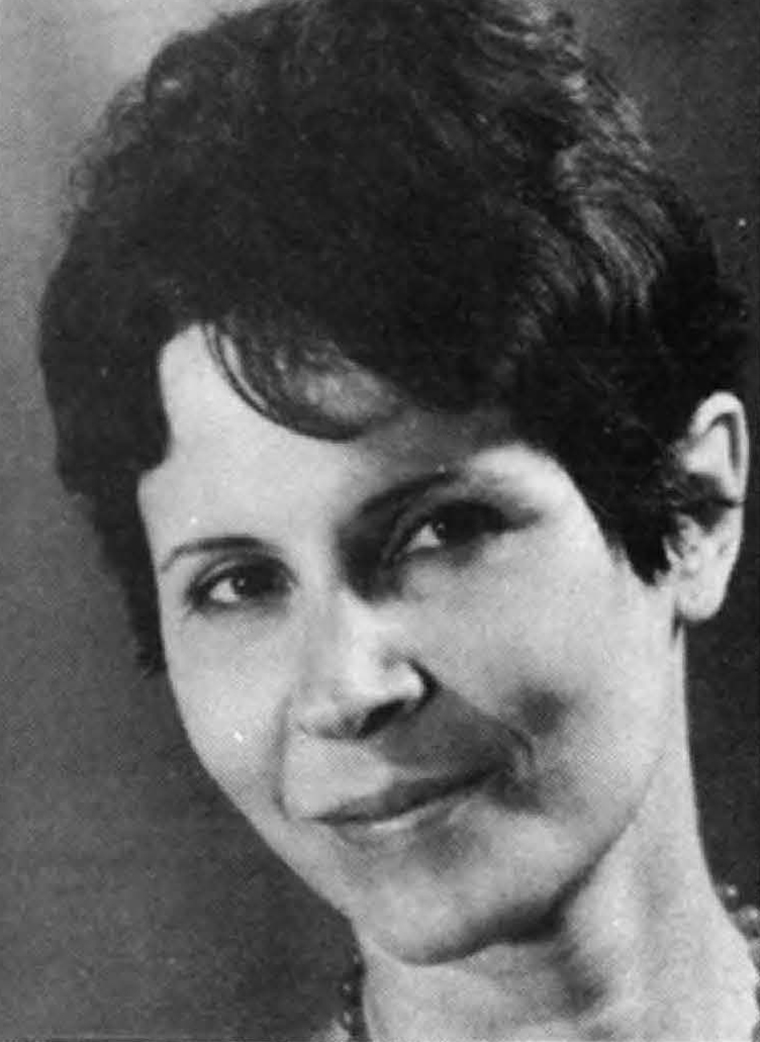
MARILYN BENTOV
Marilyn Bentov
Durham, N.C.
THE SUN is one of my reference points for what I am, always, really doing, no matter the actions experienced and perceived in so-called outer reality. Its existence reifies the tone, sometimes the quality, of my internal choreography. It is a matter of some importance to me that THE SUN is there, even when an issue or two perplexes me or leaves me indifferent. I can always trust that there is, will be, an inexhaustible number of shells and pebbles in its sands that delight, and evoke wonder.
Right now, I’m very much involved in studying projects, prophetic phenomena, and other not-so-related-except-delusionally-common-but-denied states of human trance and receptivity. I’m running a small school part time, recovering from pneumonia, and writing a long piece — don’t know if it’s an epic poem, a story, a novel, or a nameless wordweaving — that reveals the inner journey of a woman through her study and writing about the prophetess Miriam. It’s an exploration and articulation of the discovery, meaning, and enactment of power for an aging woman. I know many remarkable, if not noted, aging women: it’s their story and mine.
Marilyn Bentov’s “Song for Itzhak” appeared in Issue 71.
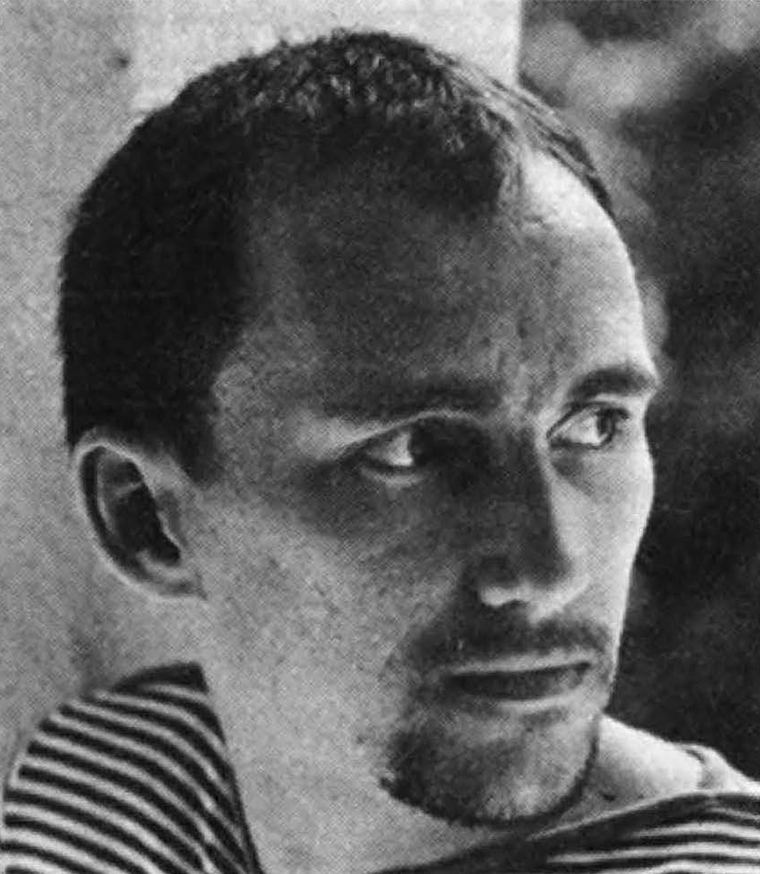
JEFFERY BEAME
Jeffery Beame
Chapel Hill, N.C.
I moved to Chapel Hill in 1975 having just received my art degree and choosing the Paris-of-the-South as the right place to ground my spirit and take on the lineaments of practical life in the real world. In these eight years my most important dreams have become reality and my life’s richness truly immeasurable.
THE SUN was the first place in this community where I chose, and more importantly, which chose me, to share my poetry and my thoughts. No matter what changes my own work has taken and despite transitions in the magazine, Sy and THE SUN have always remained open to my work and given me courage to continue in my own way.
Through the years THE SUN has surprised me with sychronic foresight, delighted me with an uncommon humor, and even sometimes disappointed me with a facile spirituality. But for all its gifts and its few faults, it has remained serenely human. Much food for the spirit has been gleaned from its pages . . . food which seemed at times to speak directly to me — as if THE SUN was a channel created for my own development — a feeling I’m sure many readers have had. Its gifts to me have more than amply paid me for drawing Sy’s attention to the quote which ended up as THE SUN’s “motto”: “What is to give light must endure burning.” I’ve burned and burned and become a new person in the time I’ve known THE SUN, and it has played a fine part in the changing.
I’ve always said the true artists among us are those people who go about their lives doing no art but living, becoming fully themselves. I’ve been fortunate to know a few of those wise ones and my whole movement in writing has been toward achieving such wisdom. In the past year I’ve come closer to it. Creative “product” has become less frequent and more diverse and basic. Less necessary and more integral. I’m not only writing now but also drawing, gardening and most importantly learning to make my lot in life, itself, a work of art and a prayer. For this I have two people; my lover, Stanley, and my best friend, Sue, to thank . . . one the perennial artist struggling to be more peacefully human, the other one of those wise ones mentioned earlier.
My life and work have never seemed more scary and more in tune and unconscious. I’m working closely with William Carlos William’s idea of an American meter. My second volume of poems, Apostrophe to Stanley and other poems, a book of love poems more vulnerable than the others I’ve written, is due this year. Three other manuscripts, What Inn is This?, Ouspensky’s Questions, and The Beautiful Tendons, are making the rounds for a publisher interested in my feeble insights into love, the Body and the Spirit. The drawing I mentioned earlier has taken me back to my first childish play and I’m having fun rediscovering a purely uncosmetic response to creative art. Gardening has given me once again a common identity with growing things which my grandmother imparted to me. A lot of energy is going into the five acres my lover and I purchased and the small house we’re preparing to build. The past year has also seen me into a new job, Assistant to the Librarian at UNC-CH’s Botany Library . . . a whole new world of information I knew little of before.
I’ve grown to a new relationship to the world — less eager to transcend and more willing to be in it. In this way I feel THE SUN and I have much more in common. Sy and the magazine have faced the same hazards we readers face in life’s struggle. The tenth anniversary of THE SUN testifies to the rewards of steadfastness and struggle, to the surity of dreams’ attainability, and to the perfection resonate in accepting imperfection. I wouldn’t want THE SUN to always please me, to always teach or transform me; but its imperfect and human tension requires that I recognize my own fragile place in the world and reminds me that the impulses to be and to grow are in a way self-fulfilling prophesies.
THE SUN foretold itself in its first determined mimeographed pages. The first decade foretells many others. Happy Birthday Sy, and wishes for many more to come. The burning won’t stop, but may each flame burn hotter and brighter.
Jeffery Beame’s most recent poem was “A Kenning for Robert Bly” in Issue 96.
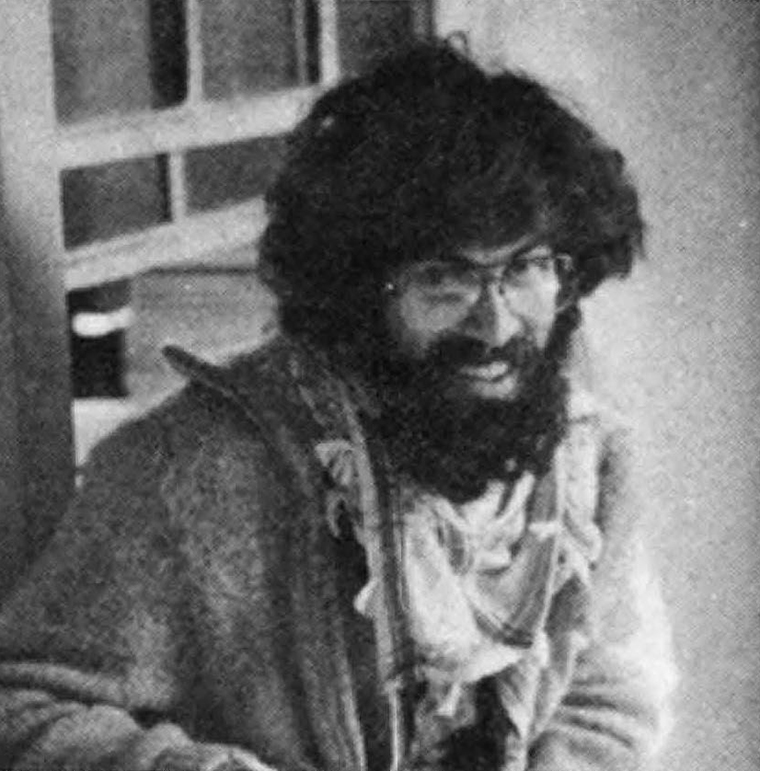
SCOTT PARKER
Scott Parker
Chapel Hill, N.C.
THE SUN is a radiant old structure of yellow. I know it is yellow, colonial yellow, because that’s what color the bits of paint in my beard are.
“You’ve been painting?” folks ask lately.
“Yup. Painting THE SUN.”
Inside are gentlefolk, going about their tasks with love. It’s always felt like a co-op foodstore to me, with its simple serenity and sense of right livelihood, perhaps an ashram. Sy is our patriarch, our accomplished master, performing those mystical acts which make a stack of magazines appear in the front hall once a month.
As families go, I guess I’m the adopted son. I feel blessed in this respect.
Myself, I am a refugee of the planet Earth. I like homegrown veggies, fine-tuned Volkses, well-proofed SUN copy, fruitful (but not particularly fruit-filled) dumpsters, a good reggae ridim, Mexican food and Karen, to name a few.
Scott Parker does volunteer work at THE SUN.
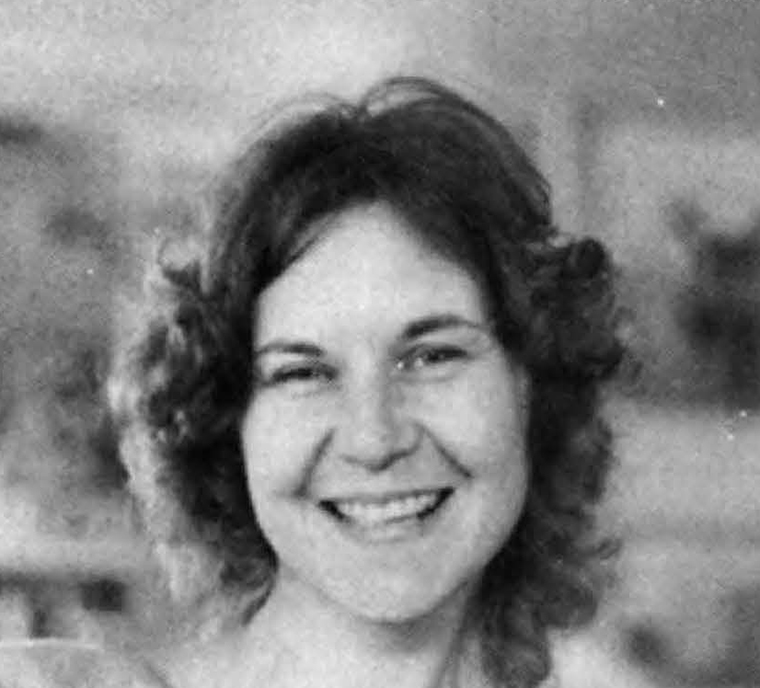
CAROL LOGIE
Carol Logie
Hillsborough, N.C.
I am drawn to consideration of what it is like to be a woman — coupled with a feeling of invisibility. With some urgency I try for explanations clear enough to allow me to be seen and run into problems: a saddening startle coming up against the need to advertise the dilemma — to speak convincingly of the invisibility itself — even before finding explanations clear enough to undo it; and then, the difficulty of sorting out those concerns which I share with other women from those more particular to me. I use THE SUN to help with both. I use Sy.
Johnny Carson jokes with Erma Bombeck — for just a moment — about the fun of not understanding women. I cannot tell him that the mystery is no longer an elegant protection but maddening. I can’t shake him nor tell anyone yet. Bu Sy is listening, frank about the distance between the stories which come in the mail describing “his pain” and those describing mine — and there to try to understand as I decide to be heard. And meanwhile there are conversations about our neuroses and attempts to beat them with clarity which help to spell out the clutter and separate it from the concerns. For this, I stay.
And now I hear the editor’s voice: yes, yes but what about THE SUN?! Just as when I talk about a piece and he asks, “Yes, but should we use it?” The lines are hazy between leaning and being leaned on; reading and contributing; using and being used. It is the luxury of floating between the roles which I appreciate. And the man whose style encourages it.
Showing up at THE SUN office in the morning is a pleasure. With affection for the ease, the thoughtfulness and the humor. Almost always humor. . . .
Carol Logie is the assistant editor of THE SUN.
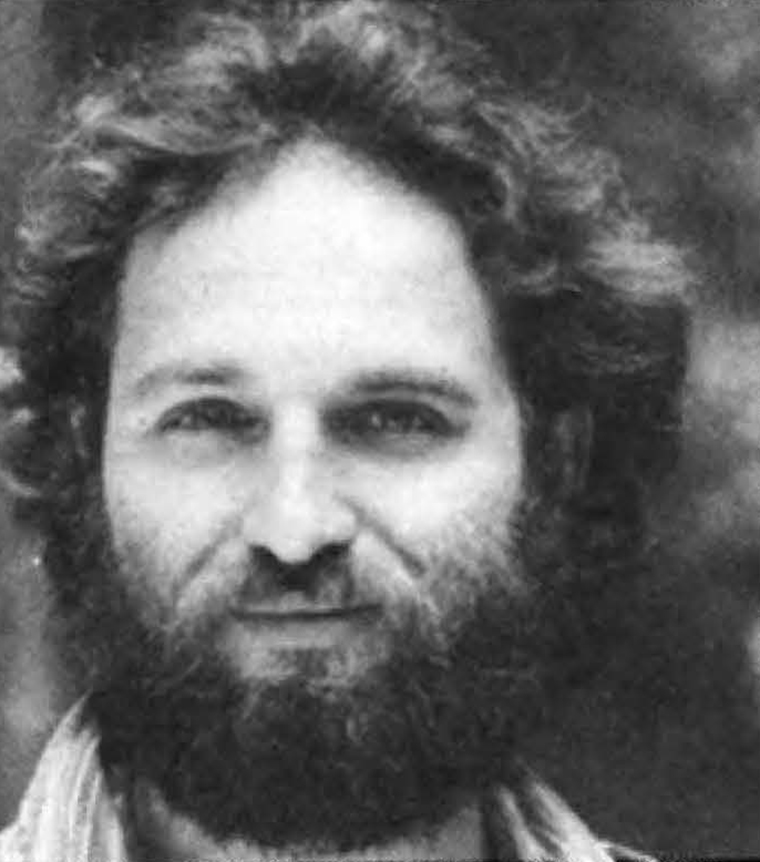
LEIF DIAMANT
Leif Diamant
Silk Hope, N.C.
I grow more peaceful, open, full, and, in some ways, less full. I learn and have learned much about love, pain, faith. More nooks, facets of my heart and mind seem accessible. And I facilitate other people learning, feeling, changing, growing through my practice of psychotherapy and hypnosis which I do about 25 hours a week. I also teach counseling and communication skills at Duke University Medical Center. I also enjoy many hours a week on my land, working and playing. Work and play, in all aspects of my life, seem less distinguishable.
And THE SUN shines into my life, a most welcome guest. THE SUN frequently surprises me as it helps stir the tears that want to fall or the love that wants to open. During some critical times, THE SUN has been the vehicle that lifted me for a dark night of my soul to feeling joy again. My deep thanks to Sy, to the staff and contributors and readers of THE SUN.
Leif Diamant wrote an advice column called “Channel One” and, later, “Shadow Dancing” in the late ’70’s.

KARL GROSSMAN
Karl Grossman
Sag Harbor, New York
Since THE SUN rose, I’ve written two books, Cover Up: What You Are Not Supposed To Know About Nuclear Power — an excerpt of which appeared in THE SUN — and The Poison Conspiracy. I’m completing a third, Nicaragua: America’s New Vietnam? I am anchor at WSNL-TV on Long Island, a journalism professor at the State University of New York, College at Old Westbury, and Southampton College of Long Island University, a syndicated columnist in Long Island newspapers, a commentator on WRCN Radio on Long Island.
There is no publication in America which has the purity, the honesty, and attains the spiritual heights of THE SUN. During a turbulent time, THE SUN has been a beacon to me and many others.
Karl Grossman’s humor pieces appeared in the late ’70’s.

JOHN COTTERMAN
John Cotterman
Lunar Graphics
Chapel Hill, N.C.
For the last three years my typesetting and design business has shared the old house on Rosemary Street with THE SUN. We share the typesetting system as well as the leaky pipes, the pigeons and mice, the too weedy garden, the coffee corner. We just finished giving the 50-year-old house a fresh coat of yellow paint.
While we share our successes and disappointments across the hall, I have little direct input to the magazine save typographic advice and a few photographs. That’s my boy on the cover of Issue 86. I’m a proud papa and a busy one. Parenting and running a small business absorbs the bulk of my energy. I find I read less and less. Some of this I interpret as a desire to simplify and focus my media input, some as laziness. Hence I sometimes read THE SUN, sometimes not.
I often browse drying type galleys and generally enjoy what I read. I see the metaphor of a restaurant kitchen worker who finds the aromas of food preparation mostly pleasant and inviting, but chooses to eat little.
Our building is a comfortable place to work. THE SUN is good neighbors.
John Cotterman runs Lunar Graphics, the other half of 412 West Rosemary Street.
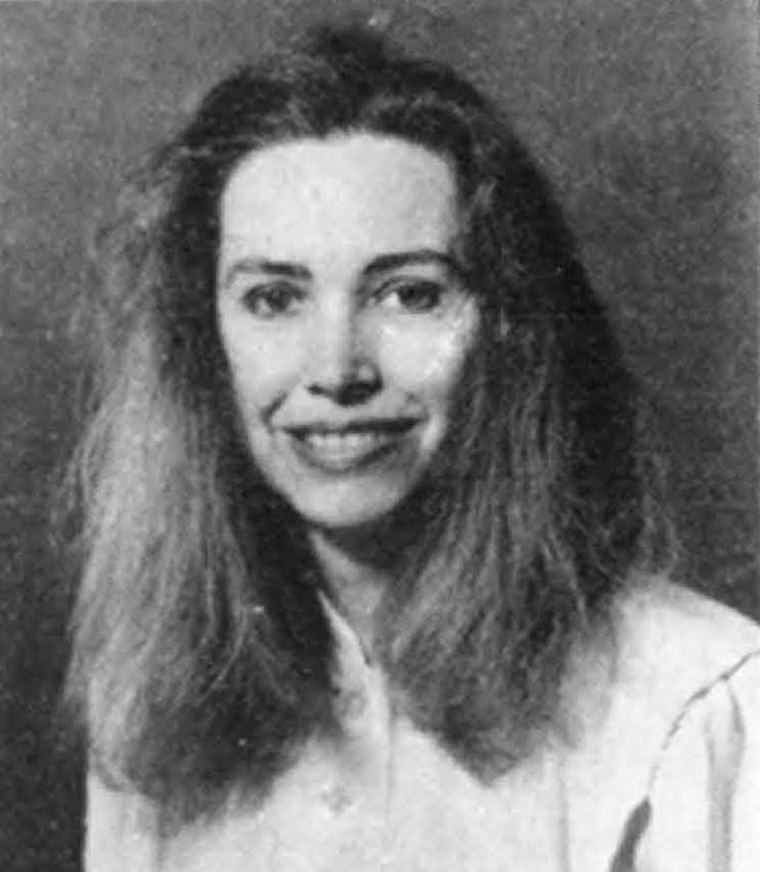
CHERYL SCHILLING
Cheryl Schilling
Everett, Washington
These days, I’m writing about my participation in the democratic process, as a woman in the race for U.S. Senator. A longer than normal list of candidates, 33, introduced an element of the bizarre to machine politics and procedures in the Washington state primary special election, recently held.
Nothing else that I am doing seems like I am doing anything. That’s politics. Baking a loaf of banana bread is the outstanding activity of the week. Other than that, I’ve met more interesting people in Everett, lately, and cultivated relationships closer to home. That’s politics.
THE SUN comes up when my life is at its best. I’m not very sentimental about most things, not consciously, anyway. But I do remember that THE SUN is the first and only magazine to date to ask me to reprint a previously published work. It was “Winning in America,” and it was my first piece published in THE SUN, 1978. I have generally been so pacified by publication in THE SUN about once a year that I have not sought publication in many other magazines. It is like a close relative. When it is around, I’m starkly aware of contrasts, competitions, similarities, coincidence, quality, past and future thinking. I really love the quest for reality in spiritual thinking — and the mystery of life unfolding in its pages is as significant to me as that which I discover on the streets. More so, because I think the pen represents an attempt to transcend what isn’t useful immediately, and in non-violent language. But that doesn’t really say what I mean. The people who write in, who I imagine reading it, who work for it, are just as fascinating to me as individuals I’ve met. THE SUN and I share a wavelength as real as my true love, as the objective facts of my life, as brother and sister, and I acknowledge the prudence and wisdom of its editor, Sy Safransky, as the key ingredient in our mutual acceptance of each other’s goals.
Cheryl Schilling’s most recent essay was “The Main Thing” in Issue 85.
Mitzi Morris
Chapel Hill, N.C.
Ah, my first piece in THE SUN, though you’ve all seen the commas, semi-colons and quotation marks that I’ve added.
When Sy asked me to write something, I couldn’t think of a thing. So, he said, “Write about what you like or don’t like in THE SUN.” What I hate about THE SUN are these “—.” Those long hyphens are complicated to enter on the computerized typesetter. I also hate all the old manual typewriters around here. But I do like the people and the place, especially the pictures all over the walls, this old heater (that I have my feet propped up on now) and the green paisley curtains in Sy’s office.
Well that’s what I like and don’t like. Now for what I really want to say. The past few days I’ve been typesetting your pieces about THE SUN and I’ve seen a lot of anger, unhappiness and cynicism. Is it really that bad out there? I say out there because I’m not in the “real world”; I’m in college. I’m happy and I think if you really thought about it you’d realize you’re lucky and you should be happy. Thanks to all of you who wrote in about how good your life was. It gives me hope. I hope that in fifteen years when THE SUN celebrates its twenty-fifth anniversary I’ll still be happy. I hope that those of you who are unhappy discover something wonderful and realize it when you do.
Well, I’ve been setting type for a few hours and I’m hungry. So, I think I’ll go home and eat and dream.
Mitzi Morris does volunteer work at THE SUN.
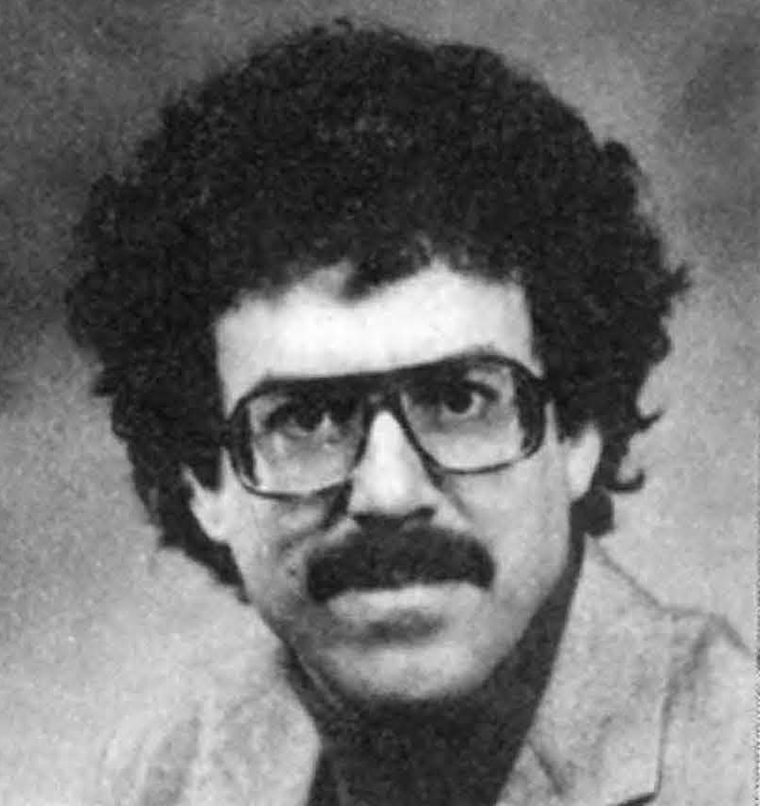
DAVID CITINO
David Citino
Marion, Ohio
Congratulations on you tenth anniversary!
I’m certain there are people around who don’t realize what an accomplishment it is for a “little” magazine to have endured for a decade. Your accomplishment is all the more remarkable in light of the fact that you’ve not been content merely to endure; you’ve grown, developed, synthesized countless theses and antitheses.
I never know what each month’s SUN will bring. You never fail to catch me off guard, surprise me in all the best ways. Your shining casts shadows for me that dance and leap in unique ways.
Thirty-five poems of mine have made their ways into ten of your issues during the past six years. To say anything less than that you’ve made a real difference in my life with your labor and care would be to speak less than the truth.
I look forward to the twentieth anniversary issue!
David Citino’s “Appassionata” poems appeared in Issues 89 and 80.
Virginia Love Long
(also known as Mariposa/Virginia L. Rudder)
Hurdle Mills, N.C.
I’m keeping the homefires burning: luxuriating in the lush gold of hickories and elms and tulip trees, the blackgum’s bright flame; putting the final touches on my third poetry collection (a family of country places and faces, All Roads Lead To Bushy Fork) prior to casting it upon the treacherous shoals of publication; pushing the joys of peaceful coexistence upon assorted cats and dogs; job hunting; talking to the moon; gleefully anticipating breaking into British print; discovering archaeology; learning new ways of loving; loving life; living from SUN to SUN. Since the first TV Guide-sized issues, THE SUN has been one of my major contacts with the wider world, another new sky where I am free to test my wings, a meeting place where poetry counts and matters. An untiring sense of wonder is a common essential for being, and THE SUN continues to sustain mine, for which I thank you. Happiest anniversary: we will, gods willing, enjoy many more. Shine on!
Virginia Love Long’s most recent poem was “Here Is How Things Are” in Issue 95.

BENJAMIN BLACK
Benjamin Black
Raleigh, N.C.
I’m a middle-aged dreamer, trying to figure out how to develop and trust my intuitive powers. I am attracted to THE SUN because, the magazine reflects my dream of and belief in a better world — now!
Benjamin Black does volunteer work at THE SUN.
Paul Crellin
Chapel Hill, N.C.
To me THE SUN is an atmosphere — the old building with its ink-stained wooden floors, tall walls and modest furniture; the endless cups of morning coffee and diverse conversations; the month gearing for production day; and the magazine itself, reflecting an aspect of American life uncluttered by the desire to sell itself.
In my junior year at college I was able to be a part of the magazine after answering Sy’s ad for apprentices. Working at THE SUN widened my horizons and I feel lucky to have been a part of it.
Paul Crellin helped out at THE SUN in 1981 and 1982.
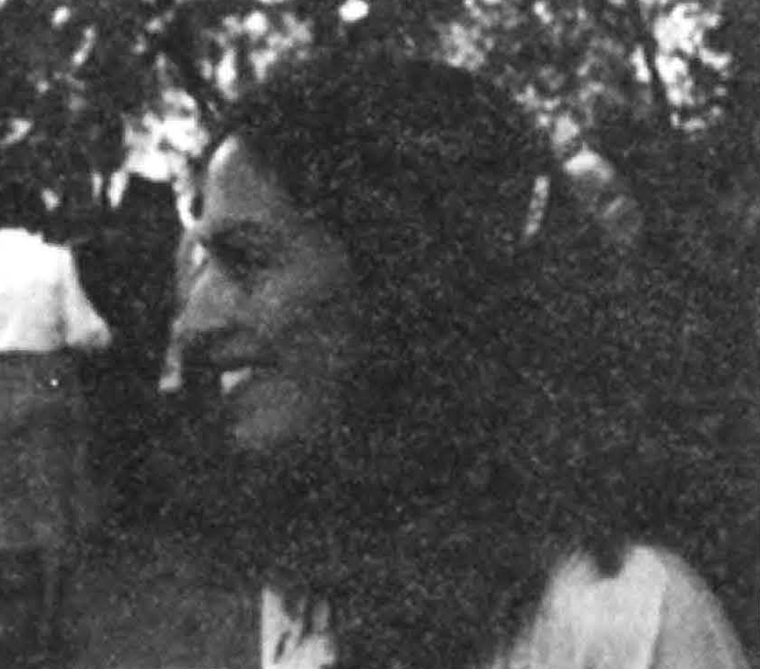
LAURA MANSBERG
Laura Mansberg
Chapel Hill, N.C.
I have a much more indirect relationship with THE SUN than I once did. I am still affected by its life, by browsing through each issue, and even more so, by my tender social/personal links. THE SUN is still a light amidst the mostly-darkness because I find there reminders that positive trends exist. Volunteering at THE SUN gave me the opportunity to do something very different (and to my liking) than the work of getting a graduate degree in a science. I still look toward it to provide “something different,” and it usually does. I am still a botanist, and work in the world of conservation and protection of rare plants. I am also working toward writing better poetry.
Laura Mansberg helped out at THE SUN from 1981 to 1982.
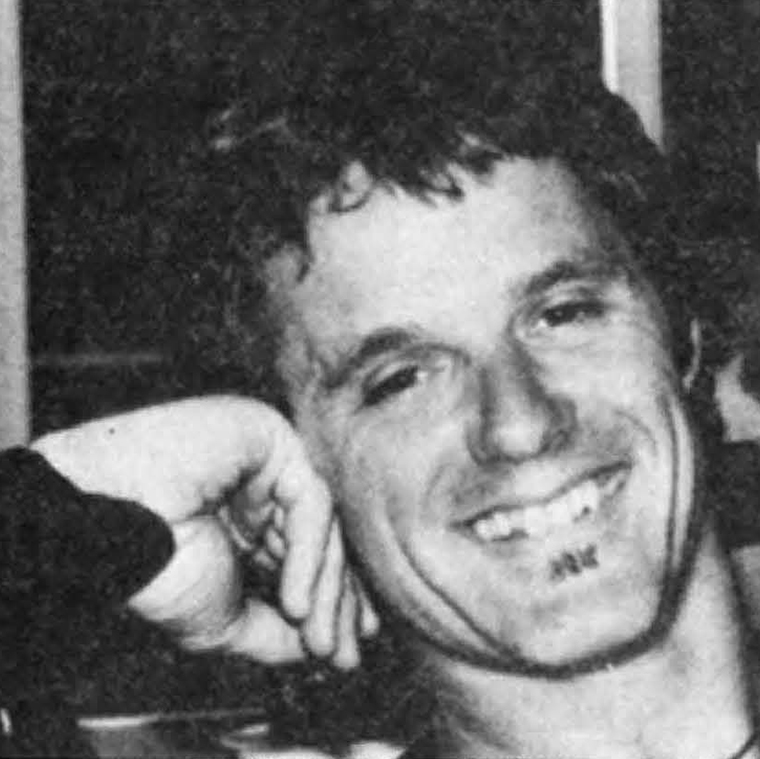
RICHARD STROZZI-HECKLER
Richard Strozzi-Heckler
Larkspur, California
How I respect your fortitude and integrity in publishing THE SUN. You have the body of a Volkswagen but the spirit and heart of a Jaguar. I have always been deeply pleased to appear in your pages and I pass you on to those that I know. THE SUN is truly for the people, as a voice to them and a voice for them. I wish you many many more birthdays!
Richard Strozzi-Heckler wrote “The Horseman of Marrakech” in Issue 40 and “The Bear” in Issue 65.
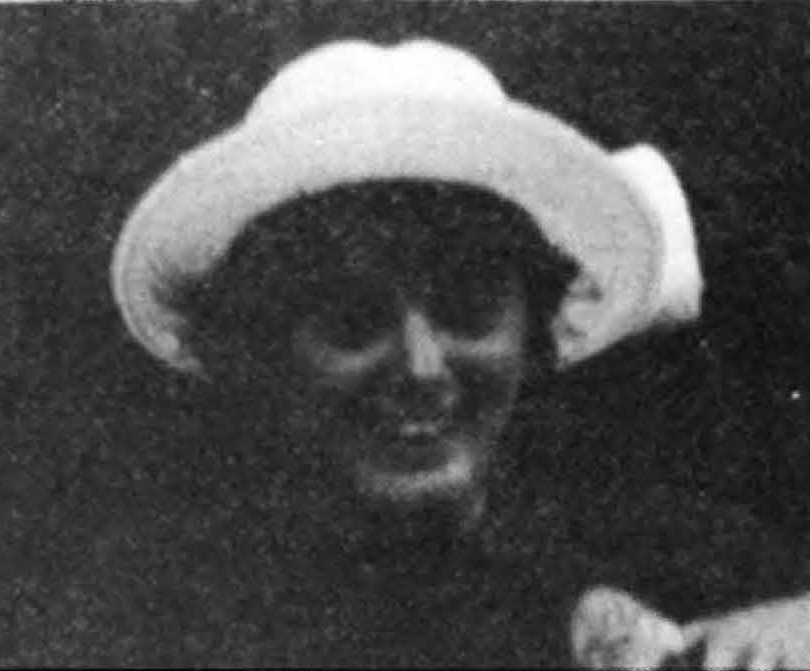
EBBA KING
Ebba King
Raleigh, N.C.
THE SUN, ever since I bought my first copy from Sy on the streets of that forever sunny town, has been a typographical delight. I thank Sy for printing some lines of mine, which now — ten years later — may have been appropriate for a new age, a difficult topic to follow in my present environment — the library.
Ebba King’s “A Walk Down Main Street” appeared in Issue 8.
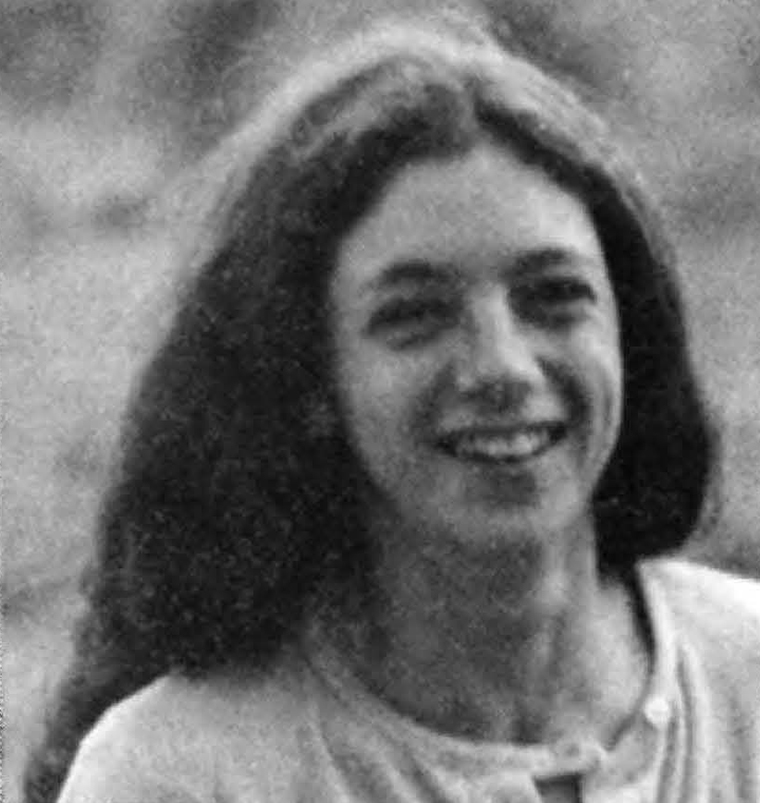
NORMA TAPPE-SAFRANSKY
Norma Tappe-Safransky
Carrboro, N.C.
It is difficult for me to separate THE SUN from its editor. Not because I feel the issue is saturated with his writings or view of the world but rather, as his friend, helper and wife, I watch Sy gracefully putting each issue together. I watch the monthly, cyclic dance — reading manuscripts (How will the readers read this? Is it coming from the very core of the author? Are its assumptions accessible?. . . .), answering the mail, proofing the type carefully set by Carol or Mitzi, choosing the art, and meticulously pasting the issue together. Like some grand menstrual cycle, Sy’s work with THE SUN gives me an appreciation of my own ebb and flow.
For those who only read THE SUN, some of the miracle is missed (though I would say this is less true of THE SUN than other publications). During the two years that I’ve been SUN-watching, I’ve concluded that THE SUN is held together by faith. Primarily Sy’s faith that it is his Work. This was a rather dramatic conclusion for my rational, scientific sort of mind to come to. But over and over again I’ve seen “the universe” respond to THE SUN’s needs, whether it’s in the form of articles for the magazine, money, volunteers or some miraculous expansion of time so that all the work gets done. And I’ve seen that time and time again the vehicle of these miracles is Sy. His persistence and insistence that THE SUN will continue manifests in long hours of hard work (none of it glamorous), an uncompromising attention to quality, patience and faith.
Norma Tappe-Safransky handles subscriptions and advertising and, as wives do, Sy.





